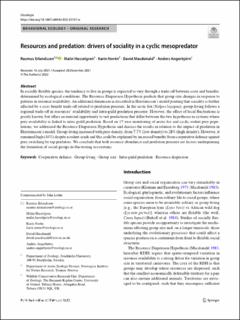| dc.contributor.author | Erlandsson, Rasmus Ingel | |
| dc.contributor.author | Hasselgren, Malin | |
| dc.contributor.author | Noren, Karin | |
| dc.contributor.author | MacDonald, David | |
| dc.contributor.author | Angerbjörn, Anders | |
| dc.date.accessioned | 2022-12-14T11:59:35Z | |
| dc.date.available | 2022-12-14T11:59:35Z | |
| dc.date.created | 2022-02-03T09:45:14Z | |
| dc.date.issued | 2022 | |
| dc.identifier.issn | 0029-8549 | |
| dc.identifier.uri | https://hdl.handle.net/11250/3037686 | |
| dc.description.abstract | In socially fexible species, the tendency to live in groups is expected to vary through a trade-of between costs and benefts, determined by ecological conditions. The Resource Dispersion Hypothesis predicts that group size changes in response to patterns in resource availability. An additional dimension is described in Hersteinsson’s model positing that sociality is further afected by a cost–beneft trade-of related to predation pressure. In the arctic fox (Vulpes lagopus), group-living follows a regional trade-of in resources’ availability and intra-guild predation pressure. However, the efect of local fuctuations is poorly known, but ofers an unusual opportunity to test predictions that difer between the two hypotheses in systems where
prey availability is linked to intra-guild predation. Based on 17-year monitoring of arctic fox and cyclic rodent prey populations, we addressed the Resource Dispersion Hypothesis and discuss the results in relation to the impact of predation in Hersteinsson’s model. Group-living increased with prey density, from 7.7% (low density) to 28% (high density). However, it remained high (44%) despite a rodent crash and this could be explained by increased benefts from cooperative defence against prey switching by top predators. We conclude that both resource abundance and predation pressure are factors underpinning
the formation of social groups in fuctuating ecosystems. | en_US |
| dc.language.iso | eng | en_US |
| dc.rights | Navngivelse 4.0 Internasjonal | * |
| dc.rights.uri | http://creativecommons.org/licenses/by/4.0/deed.no | * |
| dc.subject | Cooperative defence | en_US |
| dc.subject | Group-living | en_US |
| dc.subject | Group size | en_US |
| dc.subject | Intra-guild predation | en_US |
| dc.subject | Resource dispersion | en_US |
| dc.title | Resources and predation: drivers of sociality in a cyclic mesopredator | en_US |
| dc.type | Peer reviewed | en_US |
| dc.type | Journal article | en_US |
| dc.description.version | publishedVersion | en_US |
| dc.rights.holder | © 2022 The Authors | en_US |
| dc.subject.nsi | VDP::Matematikk og Naturvitenskap: 400::Zoologiske og botaniske fag: 480::Økologi: 488 | en_US |
| dc.source.pagenumber | 381–392 | en_US |
| dc.source.volume | 198 | en_US |
| dc.source.journal | Oecologia | en_US |
| dc.identifier.doi | 10.1007/s00442-022-05107-w | |
| dc.identifier.cristin | 1997268 | |
| dc.relation.project | EU: EU-LIFE through SEFALO | en_US |
| dc.relation.project | EU: EU-LIFE through SEFALO+ | en_US |
| dc.relation.project | EU: EU/Interreg Sweden Norway Felles Fjellrev I | en_US |
| dc.relation.project | EU: EU/Interreg Sweden Norway Felles Fjellrev II | en_US |
| dc.relation.project | Swedish Research Council: FORMAS (No. 2015–1526) | en_US |
| dc.relation.project | Andre: Fjällräven International AB | en_US |
| dc.relation.project | Andre: World Wildlife Found Sweden (WWF) | en_US |
| cristin.ispublished | true | |
| cristin.fulltext | original | |
| cristin.qualitycode | 2 | |

